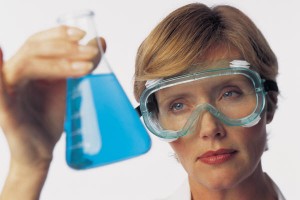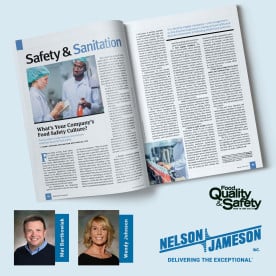 From school labs to medical labs to QA/QC labs in places like the food industry, eye protection is a safety concern that receives a lot of attention. Rightly so, as every day in the United States, about 2000 workers are treated medically for an eye injury. In addition, eye injuries "alone cost more than $300 million per year in lost production time, medical expenses, and worker compensation." The proper use of goggles and safety glasses can make a significant difference in lowering these numbers.
From school labs to medical labs to QA/QC labs in places like the food industry, eye protection is a safety concern that receives a lot of attention. Rightly so, as every day in the United States, about 2000 workers are treated medically for an eye injury. In addition, eye injuries "alone cost more than $300 million per year in lost production time, medical expenses, and worker compensation." The proper use of goggles and safety glasses can make a significant difference in lowering these numbers.
One can browse through countless policy manuals for schools, government agencies, and some industrial settings, where eye protection is mandated. With such universal attention paid to eye safety, why do the numbers of injuries and costs remain so high? The answer isn't a simple one, but some factors can include the following: compliance and standards issues, user error, or simply put: momentary indifference.
Compliance and standards issues involve many possibly enabling factors for eye injuries in the lab. A lack of employee training can factor in, as can a lack of knowledge of federal and state standards. For instance, an employee may not understand that their daily glasses do not provide sufficient protection. Contact users and glasses-wearers need to have additional eye protection, such as goggles that fit around the glasses, or have their prescription incorporated into an ANSI Z87.1 compliant design. These issues may seem quite obvious to some operations, but these causes for concern continue to occur in the lab. To learn more or to refresh your knowledge on eye protection in the workplace click here.
In terms of accidents in the lab, user error is another factor that can come into play. Employees need to ensure that their eye protection is Z87 compliant. Further, they need to know what kinds of hazards exist, and to select the proper eyewear for those hazards. Finally, the eyewear must be properly fitted. For some helpful information on hazards and choosing the proper eyewear for the job, click here.
An article dated December of 2011 from The Harvard Crimson illustrates well how indifference can also lead to troubles in the lab. Though a lab safety handbook declared that eye protection must always be worn in the lab, and despite the fact that lab assistants “reinforced” the need to wear eye protection, a group of students “were exposed to ultraviolet light” in a lab. This exposure to UV light led to a steady stream of students in severe pain showing up to the Harvard University Health Services urgent care that same evening. A student that suffered an injury from this exposure discussed the fact that safety precautions were taken, but students were “in a lazy kind of mood” during the lab and didn’t wear proper eye protection. With the semester’s end being just days away, she described it as “last-lab fever.”
A long stream of responses to the story debated where blame rested, whether it was with the students or the teaching assistants. It is safe to say, no matter what side of the debate a person was on, that an important lesson on lab safety was learned. Even if standards and practices are not followed momentarily, injury can result. Many who work in a lab can identify with times, where at certain points of the day or in certain contexts, one may say, “I should be fine without…” As this incident illustrates, such moments at any lab have the potential of producing some those 2000 daily cases of eye injuries discussed above.
In addition to the three themes discussed here, there are numerous other factors that play into the 2000/day figure. Proper training, knowledge of the federal and state standards, proper fitting, and encouraging/practicing diligence throughout the day are some practical areas to address in your operation, but only address part of the problem. To find out more about eye safety and other personal protective equipment in the workspace check out this helpful document from the Occupational Safety and Health Administration.
Click on the links to see some popular models, including eye safety wear from Centurion, Seepro, and Jackson Safety.





